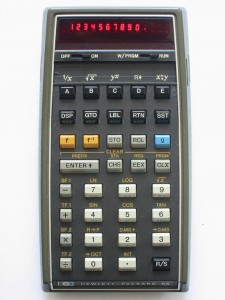The HP-65 calculator has an internal set of status flags known as the “s register”. “s3” is one of those flags but it behaves a bit strangely … Continue reading HP65 s3 – W/PRGM
Category Archives: hp65
HP65 s5 – Memory Full
s5 is used to record “memory full”. Here’s an example: Continue reading HP65 s5 – Memory Full
The HP65 Wait Loop
When the HP-65 calculator is sitting idle, waiting for you to get it to do something, what is it thinking? What’s going through its head? Continue reading The HP65 Wait Loop
The HP65 M Register
The M register in the HP-65 is used for a lot of very interesting things. Maybe not quite “give me the contents of the M register and I’ll show you the world”; but it is very close to that. Continue reading The HP65 M Register
The HP65 Buffer
There is a variable in the HP65 emulator named simply “buffer”. What is it? What does it do? Why is it there? Continue reading The HP65 Buffer
HP65 Flags
The HP-65 calculator has two flags and you can set, clear or test these in your programs. They allow you to remember choices or situations for later. Something happens. You use f SF 1 (or f SF 2) to remember it, and later you use f TF 1 (or f TF 2) to choose between two different courses of action.
Where are the flags stored? How does it do all that? Continue reading HP65 Flags
HP65 Program Codes
When you program a programmable calculator like the HP65 you press buttons and it remembers the steps you are telling it. Then when you run the program, it re-does those button presses again to calculate the result. Every time you run the program it does those steps. This happens even though you only entered them once. That’s the point.
Internally, the calculator stores a program code for each key press or combination of key presses. With the HP65 it is mostly “one key press, one stored code” but there are a few combinations it recognises and saves as one program code. These are called “merged program steps”.
Continue reading HP65 Program Codes
HP65 Default Program
This is what ends up in program memory at startup.
000: 63 =077 001: 61 =075 002: 43 =053 003: 30 =036 004: 8 =010 005: 20 =024 006: 42 =052 007: 43 =053 008: 28 =034 009: 14 =016 010: 50 =062 011: 42 =052 012: 43 =053 013: 27 =033 014: 8 =010 015: 19 =023 016: 42 =052 017: 43 =053 018: 26 =032 019: 13 =015 020: 42 =052 021: 43 =053 022: 24 =030 023: 17 =021 024: 42 =052 025: 0 026: 0
HP65

I never had a HP65 but it was what my HP67 was based on and wow it looked like a great calculator.
The keyboard layouts were very similar too.
The f, f-1, and g keys became f, g, and h.
There was extra writing added because the new g key was no longer labelled f-1 :
– on the HP65 f 9 was square root, f-1 9 was un-square root i.e. square
– on the HP67 f 9 was square root, g 9 was square
It was no longer obvious so HP added x2 next to the square root sign.
The writing also moved from above their keys to below their keys.
Aside from a few minor changes on the second row, the keys remained in familiar positions.
You can see a HP67
So, why did people upgrade from the HP65 to the HP67?
There were lots of really good things about the HP67 and just as many reasons. A couple of obvious ones were: more memory and bigger programs. But, for many, these weren’t reasons to ditch the great HP65 – merely reasons to get a HP67 too.
